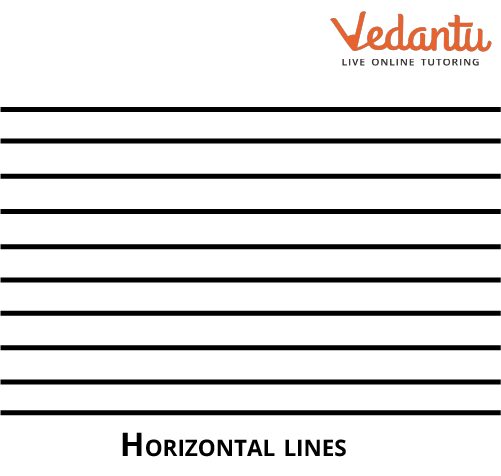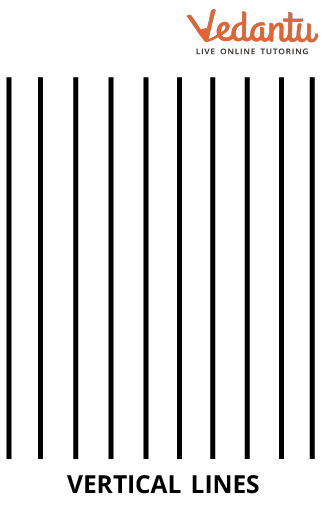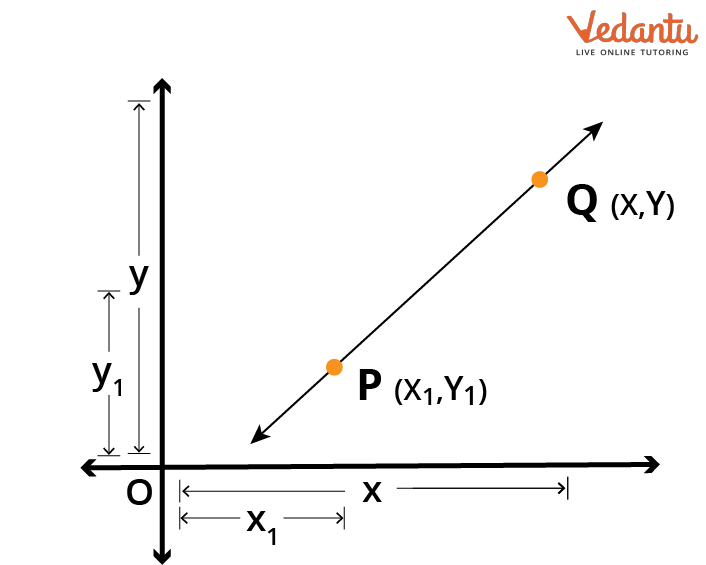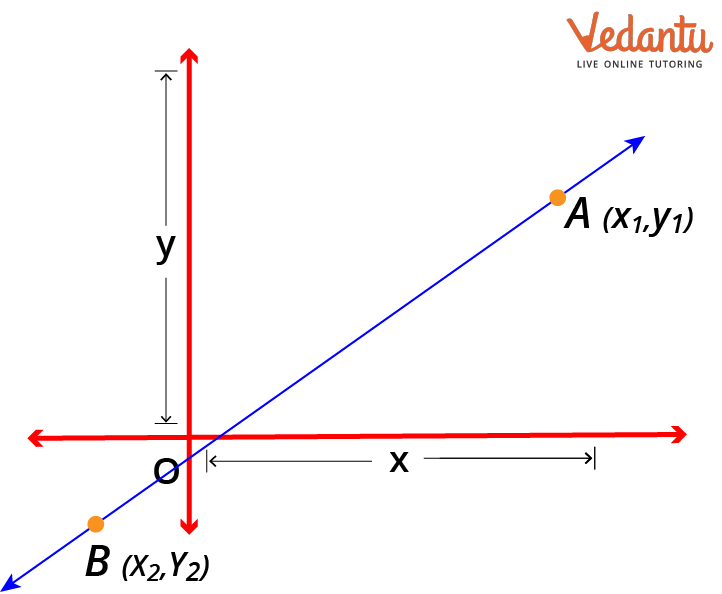




Examples and Applications of Straight Lines in Maths
The line definition, as stated by Euclid, basically states that a straight line connects any two given points and can be extended forever in both directions. The shortest distance between two points is a straight line.
A straight line is a continuous, one-dimensional shape with no breadth. It consists of an infinite number of points connected on either side of a point. It might be inclined, vertical, or horizontal. Any angle we draw between two locations along a straight line will always be a 180-degree angle.
What is a Straight Line?
A straight line has no curvature. A straight line can also be drawn between any two points, but its endpoints must stretch into the infinite. When two points, A (x1, y1) and B (x2, y2) are connected by the shortest path possible, a straight line is a result. We see straight lines in our day-to-day life, such as railway tracks, Roads, and Bridges.

Straight Line
Types of Straight Lines
There are several kinds of straight lines. The alignment of the straight lines is typically used to categorise them. The angle they make with either the x-axis or the y-axis is referred to as their alignment. Straight lines can be classified into the following categories based on their alignment:
Horizontal Lines
Vertical Lines
Oblique/Inclined Lines
Horizontal Lines
Horizontal lines are parallel to the x-axis or perpendicular to the y-axis when drawn horizontally. They intersect the x-axis at an angle of 0° or 180° and the y-axis at an angle of 90° or 270°. This line does not touch any point on the X-axis. All the points on this line will have the same Y-coordinate.

Horizontal Line
Vertical Lines
Vertical lines are drawn vertically and parallel to the y-axis or perpendicular to the x-axis. They intersect the x-axis at an angle of 90° or 270° and the y-axis at an angle of 0° or 180°. All the points on this line will have the same X-coordinate.

Vertical Lines
Oblique/Inclined Lines
Oblique or slanting lines are those that are drawn at an angle other than 0°, 90°, 180°, 270°, or 360° with the horizontal or vertical lines. Oblique or inclined lines are straight lines that are neither horizontal nor vertical.

Oblique Lines
Properties of Straight Lines
The properties of straight lines are illustrated below:
A straight line can go on forever. The distance between the line's two extreme points is impossible to measure.
It has no volume and no areas. However, its length is unlimited.
It is a figure with only one dimension.
A single point can be traversed by an endless number of lines, but only one single line can pass between two points.
Equation of a Straight Line
An equation of a straight line is a linear equation. Depending on the known variables, angles, and constants, a straight line on a plane can be represented in a variety of ways. The direction of a straight line is determined by its slope, which also indicates how steep the line is. It is calculated as the difference in y coordinates/difference in x coordinates and is also referred to as rise over run. There are several ways to write a straight-line equation.
General Equation of a Straight Line
The general formula for a straight line is $ax + by + c = 0$, where
The slope will be $\dfrac{{ - a}}{b}$.
Here, a, b, and c are constants, and x, and y are variables.
Slope Point Form:
The idea of calculating a line's slope from two points is the basis of the slope-point form. A straight line going through the point $\left( {{x_1},{y_1}} \right)$ and having a slope of $m = \tan \theta $, where $\theta $ is the angle produced by the line with the positive x-axis is given as $(y - {y_1}) = m(x - {x_1})$

Slope point form
Two-Point Form:
When two points along a line are known, the equation of the line may be found using the two-point form. Given by is a straight line that connects the coordinates $\left( {{x_1},{y_1}} \right)$ and $\left( {{x_2},{y_2}} \right)$. The two-point form is: $y - {y_1} = \dfrac{{{y_2} - {y_1}}}{{{x_2} - {x_1}}}(x - {x_1})$

Two-point form
Intercept Form:
The point where the graph crosses the axes is known as the intercept. The point where the graph meets the x-axis is known as the x-intercept if the graph crosses the x-axis. The point at which a graph contacts the y-axis is referred to as the y-intercept. The intercept form of a straight line with point A on the x-axis and point B on the y-axis, as seen in the picture below, is expressed as a straight line with the x-intercept as a and y-intercept as b. The intercept form is: $\dfrac{x}{a} + \dfrac{y}{b} = 1$

Intercept form
Straight Line Problems:
Let us look at some straight line questions and answers or Problems on Straight Lines:
Example 1: What will be the equation of the line passing through the points (2,3) and (5,4)?
Solution: To find the equation of a line passing through the points (2,3) and (5,4), we will use the two-point form:
$y - {y_1} = \dfrac{{{y_2} - {y_1}}}{{{x_2} - {x_1}}}(x - {x_1})$
Substituting the values, we get
$\begin{array}{l}y - 3 = \dfrac{{4 - 3}}{{5 - 2}}(x - 2)\\3y - 9 = x - 2\\3y - x - 7 = 0\end{array}$
Therefore, the equation of a line is $3y - x - 7 = 0$.
Example 2: What is the equation of the line which has a slope of 3 and passes through a point (2,5)?
Solution: To find the equation of the line with slope 3 and passing through a point (2,5) we will use slope point form:
$(y - {y_1}) = m(x - {x_1})$
Substituting the values,
$\begin{array}{l}y - 5 = 3(x - 2)\\y - 5 = 3x - 6\\y - 3x + 1 = 0\end{array}$
Conclusion:
We now have a basic understanding of the line and its key components due to this article. We will be able to apply the principles to real-world applications and discover more fascinating facts about the line using the many sorts of lines that have been discussed in this article.
FAQs on What Is a Straight Line in Maths?
1. What is the fundamental definition of a straight line in Maths?
In mathematics, a straight line is the shortest distance between any two points. It is a one-dimensional figure that has length but no width. A key characteristic is that it extends infinitely in both directions and has a constant slope.
2. What are some common real-world examples that illustrate the concept of a straight line?
Real-world examples help explain the concept of a straight line. Common illustrations include:
- The edge of a ruler or a rectangular table.
- A tightly stretched string or rope.
- A beam of light from a laser pointer.
- The path of a ball rolling on a perfectly flat surface without deviation.
3. What are the main types of straight lines in a coordinate plane?
In coordinate geometry, straight lines are primarily classified into three types based on their orientation:
- Horizontal Lines: Lines that run parallel to the x-axis and have a slope of zero. Their equation is in the form y = c.
- Vertical Lines: Lines that run parallel to the y-axis and have an undefined slope. Their equation is in the form x = c.
- Oblique Lines: Lines that are neither horizontal nor vertical. They have a non-zero, defined slope and intersect both axes at an angle.
4. What is the general equation used to represent a straight line algebraically?
The most common algebraic representation of a straight line is the slope-intercept form, which is given by the equation y = mx + c. In this formula:
- 'y' and 'x' are the coordinates of any point on the line.
- 'm' represents the slope, or the steepness of the line.
- 'c' represents the y-intercept, which is the point where the line crosses the vertical y-axis.
5. How does a straight line differ from a line segment and a ray?
The difference between a line, a line segment, and a ray lies in their endpoints and extension. A line extends infinitely in both directions and has no endpoints. A line segment is a finite part of a line that has two distinct endpoints and a measurable length. A ray has one starting point (endpoint) and extends infinitely in only one direction.
6. Why is a straight line considered a one-dimensional (1D) figure?
A straight line is considered one-dimensional because you only need one piece of information, or a single coordinate, to define the position of any point on it relative to a fixed origin on that line. Unlike a two-dimensional plane that requires two coordinates (like x and y), a line only possesses length, with no width or height.
7. Can two different straight lines intersect at more than one point?
No, two distinct straight lines can intersect at exactly one point at most. If two lines were to share two or more points, they would, by definition, be the same line because there is only one unique straight line that can pass through any two given points. If they never intersect, they are called parallel lines.















